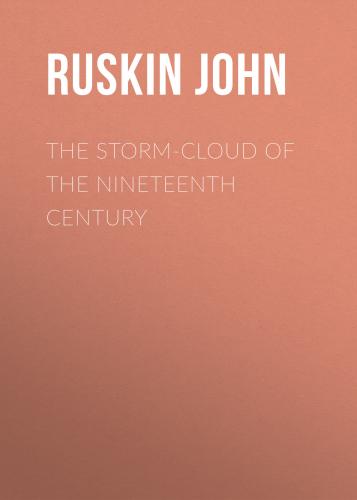but I still retained the explanation of Saussure for the lee-side cloud, engraving in plate 69 the modes of its occurrence on the Aiguille Dru, of which the most ordinary one was afterwards represented by Tyndall in his 'Glaciers of the Alps,' under the title of 'Banner-cloud.' Its less imaginative title, in 'Modern Painters,' of 'Lee-side cloud,' is more comprehensive, for this cloud forms often under the brows of far-terraced precipices, where it has no resemblance to a banner. No true explanation of it has ever yet been given; for the first condition of the problem has hitherto been unobserved,—namely, that such cloud is constant in certain states of weather, under precipitous rocks;—but never developed with distinctness by domes of snow.
But my former expansion of Saussure's theory is at least closer to the facts than Professor Tyndall's "rubbing against the rocks," and I therefore allow room for it here, with its illustrative wood-cut.
"When a moist wind blows in clear weather over a cold summit, it has not time to get chilled as it approaches the rock, and therefore the air remains clear, and the sky bright on the windward side; but under the lee of the peak, there is partly a back eddy, and partly still air; and in that lull and eddy the wind gets time to be chilled by the rock, and the cloud appears, as a boiling mass of white vapor, rising continually with the return current to the upper edge of the mountain, where it is caught by the straight wind and partly torn, partly melted away in broken fragments.
"In the accompanying figure, the dark mass represents the mountain peak, the arrow the main direction of the wind, the curved lines show the directions of such current and its concentration, and the dotted line encloses the space in which cloud forms densely, floating away beyond and above in irregular tongues and flakes."
12
See below, on the different uses of the word 'reflection,' note 14, and note that throughout this lecture I use the words 'aqueous molecules,' alike of water liquid or vaporized, not knowing under what conditions or at what temperatures water-dust becomes water-gas; and still less, supposing pure water-gas blue, and pure air blue, what are the changes in either which make them what sailors call "dirty "; but it is one of the worst omissions of the previous lecture, that I have not stated among the characters of the plague-cloud that it is
[In my final collation of the lectures given at Oxford last year on the Art of England, I shall have occasion to take notice of the effect of this character of plague-cloud on our younger painters, who have perhaps never in their lives seen a
and
13
Black clouds.—For the sudden and extreme local blackness of thundercloud, see Turner's drawing of Winchelsea, (England series), and compare Homer, of the Ajaces, in the 4th book of the Iliad,—(I came on the passage in verifying Mr. Hill's quotation from the 5th.)
I give Chapman's version—noting only that his
I add here Chapman's version of the other passage, which is extremely beautiful and close to the text, while Pope's is hopelessly erroneous.
14
'Reflected.'—The reader must be warned in this place of the difference implied by my use of the word 'cast' in page 11, and 'reflected' here: that is to say, between light or color which an object possesses, whatever the angle it is seen at, and the light which it reverberates at one angle only. The Alps, under the rose
[In speaking, at p. 11 of the first lecture, of the limits of depth in the rose-color cast on snow, I ought to have noted the greater strength of the tint possible under the light of the tropics. The following passage, in Mr. Cunningham's 'Natural History of the Strait of Magellan,' is to me of the greatest interest, because of the beautiful effect described as seen on the occasion of his visit to "the small town of Santa Rosa," (near Valparaiso.) "The day, though clear, had not been sunny, so that, although the snowy heights of the Andes had been distinctly visible throughout the greater part of our journey, they had not been illuminated by the rays of the sun. But now, as we turned the corner of a street, the chain of the Cordillera suddenly burst on our gaze in such a blaze of splendor that it almost seemed as if the windows of heaven had been opened for a moment, permitting a flood of
of sunset, are exactly of the same color whether you see them from Berne or Schaffhausen. But the gilding to our eyes of a burnished cloud depends, I believe, at least for a measure of its luster, upon the angle at which the rays incident upon it are reflected to the eye, just as much as the glittering of the sea beneath it—or the sparkling of the windows of the houses on the shore.
Previously, at page 10, in calling the molecules of transparent atmospheric 'absolutely' unreflective of light, I mean, in like manner, unreflective from their
So also the green of the sky (p. 13) is said to be given by transmitted light, yellow rays passing through blue air: much yet remains to be known respecting translucent colors of this kind; only let them always be clearly distinguished in our minds from the firmly possessed color of opaque substances, like grass or malachite.
15
Diffraction.—Since these passages were written, I have been led, in conversation with
